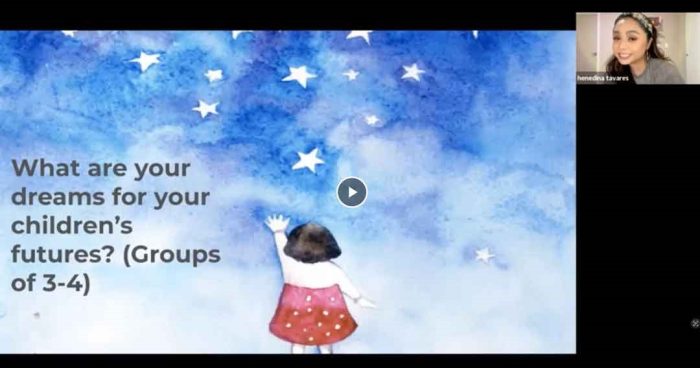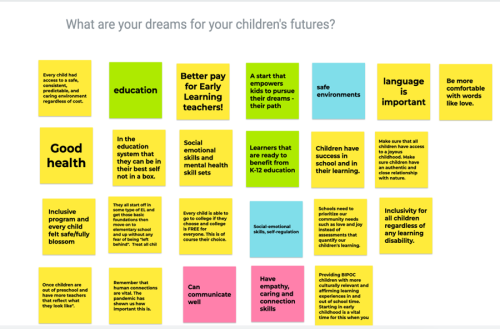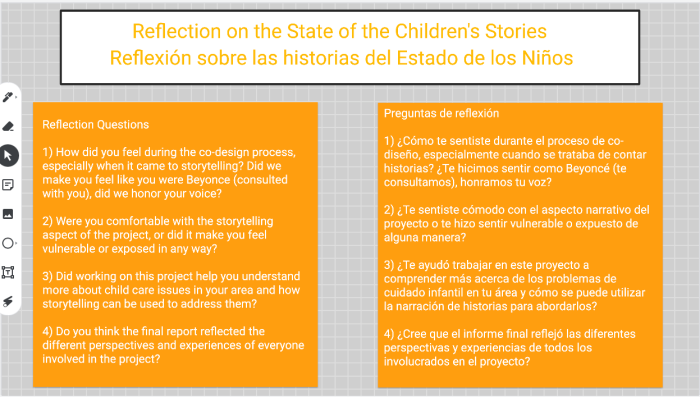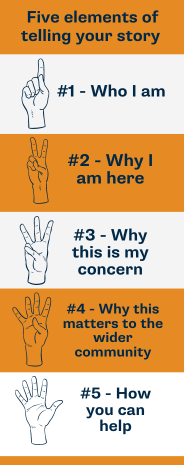Integrating Community Voices: State of the Children Co-design blog: Part II

“Washington STEM and our partners act so that ‘all children have access to a joyous childhood’ by working to increase state funding for equitable child care programs and fair compensation for child care providers, advocating for policies that support working families, and fostering collaboration with families, caregivers, providers, and other community partners.”
—Vision statement, State of the Children 2023
Written by Joanne Walby
Recognizing cultural and “home” learning
Making cookies with Grandma. Learning the prayer before meals. Identifying which berries are safe to eat. These are all examples of cultural learnings we absorb at home long before we step into a classroom.
Educational research has been known to prioritize learning in schools over learning that happens at home, which is often culturally-specific learning. This can include stories about family heritage and history, language, food preparation, and religious practices.
As discussed in a previous blog, Washington STEM is using participatory design research techniques to incorporate community-informed solutions and voices into the analysis of systemic inequities in the education system. This approach invites cultural knowledge, home practices, and lived experiences to complement the quantitative data usually found in reports so they more completely reflect and advance the priorities of diverse children and families.
By using qualitative research techniques such as interviews, surveys, focus groups, and listening sessions we can better understand the systemic barriers students face in K-12 STEM education and the foundational learning that precedes it: early learning and care.
Community as Knowledge Holders
Henedina Tavares is an education researcher at the University of Washington and a former Community Partner Fellow at Washington STEM. She facilitated the co-design sessions that produced the 2023 State of the Children (SOTC) reports.
“Traditional research partnerships don’t always include the voices of the people impacted by the research. Quantitative data on its own doesn’t tell the whole story,” she said. A community-based research approach acknowledges that communities and families are “critical knowledge-holders and creators,” and their experiences and stories can explain the ‘why’ behind the research findings.
When it was time to update the State of the Children Early Learning and Care reports, Washington STEM invited parents, families and caregivers—particularly those of children with disabilities—to help co-design the reports. This created an opportunity for community to inform what data the reports would include, as well as talk about the obstacles they faced in trying to access child care. But it didn’t stop there.
Their stories often highlighted real obstacles such as ableism, racism, and financial or bureaucratic obstacles. These kinds of nuanced insights are needed to inform policy fixes that are life-changing for those often overlooked in early learning: families with children with disabilities, children of color, immigrants and refugees, or families who don’t speak English at home.
Tavares said, “We also asked these parents and caregivers to tell us how they are resilient and how their community is showing up for each other. It’s important to center joy in this process—not to always look through a ‘deficiency’ lens but to acknowledge the strengths a community already has.”
One co-designer and parent, Danna Summers of King County, recalled an exchange she had with a teacher that was so meaningful to her. “My child is stubborn. But one time a teacher told me, ‘You have a child with the gift of knowing what she wants. Now we just teach her how to negotiate or express her needs.’ So often I hear about her limitations—‘she cannot do this, she cannot do that’. It’s so rare to hear from someone who tells me what she CAN do!”
Co-design: building trust and strengthening community
The co-design process is not just about producing a report—but about building and supporting existing community and ensuring their voices inform the policy and advocacy process.
The co-design participants reported that these discussions helped build the trust needed for them to feel comfortable sharing their experiences. Their stories often highlighted real obstacles, such as ableism, racism and financial or bureaucratic obstacles. These kinds of nuanced insights are needed to inform policy fixes that are life-changing for those often overlooked in early learning: families with children with disabilities, children of color, immigrants and refugees, or families who don’t speak English at home.

Participants as Research Partners
From August 2022 to January 2023, the co-design participants met each month online. Initial sessions included prompts for them to share their dreams for their children’s futures, which gave them a chance to talk about the children in their lives, whether they are a parent, caregiver, or educator.
“Asking about their dreams for their children allows them to focus on the joy in these relationships, despite the challenges they may face,” Tavares said.
These sessions were foundational for building trust among participants and identifying a shared vision for the future, towards which the co-designers can collectively work. As the co-designers delved deeper into the process, more valuable insights came to the surface. Tavares said, “The research outcomes we wanted—identifying gaps in the data and barriers to early learning access—came through the relationship-building process.”
Below are some examples of insights surfaced through co-design process:
Issues identified by co-designers,
|
|
|---|---|
Demographic data left out |
What isn’t tracked, isn’t measured. Children with disabilities, unhoused children, children from immigrant/refugee families, and those who speak languages other than English at home are not tracked in state-wide data. The report includes requests for state agencies to track these metrics. |
Barriers to high quality early learning and care |
One mom said she had to turn down a much-needed pay raise at work because it would disqualify her from the state’s Early Childhood Education and Assistance Program (ECEAP). Another reported that she didn’t finish her college degree because she couldn’t find child care that would accommodate her varying college class schedule. |
Choosing between career advancement or child care |
Wages for the early learning and care workforce are near-poverty level, making it difficult to recruit and retain the qualified workers needed to care for our children. Further, during the pandemic, 13% of child care programs closed across the state, often due to workforce shortages. The SOTC report includes a comparison of pre-school and kindergarten teacher salaries and a call to increase wages and quality while keeping the workforce diverse. |
Common values and vision of the future |
The Equity Vision statement was created from an explicit discussion about participants’ values. Instead of assuming a shared set of values, this discussion allowed everyone to have a voice and understand where they differed and what they shared in common. |


“People rarely remember data—but they will remember your story.”
Sonja Lennox is a Head Start Parent Ambassador. She was invited to present in a SOTC co-design session to share her experiences and advise the participants about storytelling. She spoke about how to prepare their stories for an advocacy context, such as testifying at a committee hearing in Olympia.
Lennox said when she first dropped her son off at his Head Start preschool, he would cry and cry. But she said the teachers worked with him to calm him down. “By the time he got to kindergarten, he was the one telling other kids when they’d get upset, ‘Hey, it’s going to be ok. We’ll read stories, and then it’s lunchtime!’” She said without the Head Start teachers who had the expertise and time to help him adjust and gain confidence, he probably would have been sent to the principal’s office for acting up when he got to kindergarten.
She explained, “Advocacy stories are different than speaking with a friend. We have to think about the intent of telling the story, and what are the values of the audience you are sharing it with?”
The “Beyonce treatment”: having control over how one’s story gets told
And while telling one’s personal story can be an effective advocacy tool, it can also leave a person feeling vulnerable. The co-design process recognizes that in the past, research participants did not always have control over how their stories were shared.
“A potential contribution participatory design research makes […] toward cultural change is the opportunity to better understand how individuals who experience transformative agency change and come to intervene and impact new spaces and sets of relations at particular scales of time.
—Megan Bang, Participatory Design Research and Educational Justice, 2016.
But with community-based research in general, and co-design in particular, protecting co-design participants’ privacy and anonymity are top priority. The co-designers themselves get to decide if and how their stories are shared. Shereese Rhodes, a parent in Pierce County said, “I don’t want to open up about my child’s story and then see it quoted on a Metro bus. I want the ‘Beyonce treatment’—you know, nothing goes out without her final review!”
Susan Hou is a University of Washington Community Research Fellow and a member of the Washington STEM’s SOTC co-design team. “The co-design process re-centers the voices of the people most impacted by oppressive systems—they can tell specifically what needs to change. This process reverses decades of policy development when laws and policies were enacted without consideration to how it would impact communities,” she said.
The co-design process also included a simultaneous Spanish language translator and bilingual facilitator, so Spanish speaking participants could also engage in real-time. Tavares said, “Often, Spanish speakers are excluded or silenced because no one raised the issue of translation and there was not the intentionality to bring them into the space.”
Irma Acosta is a child care provider in Chelan County who speaks Spanish and relied on simultaneous interpretation to participate in the co-design process. About this she said, “I felt welcomed and it was a space created for someone like me.”
Creating new spaces and new relationships
In December and January 2023, the co-design group met to complete final reviews of the SOTC reports they helped shape and to give feedback on the process overall. When asked to describe in 1-3 words how they felt about the co-design process, they posted: “Connection. Engaging. Thoughtful. Strong. Respect. Trust. Care. Informative. Accomplished”.
This was followed by an icebreaker: “What is the one thing you have done to take care of yourself during this past year?”
“Listening to this group speak, sometimes about very personal struggles, gave me a sense of wonder and awe—that our co-design group is so rich with experience and compassion and their knowledge is fused into the STOC reports.”
—Soleil Boyd, Senior Program Officer for Early Learning
Answers ranged from keeping an annual medical check-up that ended up being life-saving, to arranging respite care so an exhausted mom could have time to rest and restore. Another co-designer said she buys holiday gifts for local youth and includes her daughter in the shopping, “So she knows the reason for the season.” Another mom said she started believing in herself and trying new things. “I wrote two novels and applied for a job I wanted. I’m glad I started to bet on myself.”
Dr. Soleil Boyd, PhD. is Washington STEM’s Senior Program Officer for Early Learning and Care and led the co-design process. “Listening to this group speak, sometimes about very personal struggles, gave me a sense of wonder and awe—that our co-design group is so rich with experience and compassion and their knowledge is fused into the STOC reports,” she said.
Susan Hou observed, “Centering joy in our lived experiences is not only healing, but it’s a way of remembering we are resilient. This is especially important for communities that have been marginalized—to remember what they have always done in order to survive. They are not just responding to past struggles, but they are planning for their futures.”
Although the co-design sessions ended in early 2023, many participants have formed friendships and plan to continue meeting or join advocacy groups.
“The codesign process is not just about creating a report—it is about recognizing and vitalizing the strong communities all around us.”
—Henedina Tavares
“The codesign process is not just about creating a report—it is about recognizing and vitalizing the strong communities all around us,” Tavares said.
During the last session, co-design participants wrote some verse about their experiences, and combined them into a poem:
I hold myself accountable to future generations,
to those who will never know my name,
but who will feel the ripple of my actions.
Laundry is piling, dishes are rising—
they can wait.
I have another zoom meeting…
Committee, councils, boards and commission.
I’m changing the world one PowerPoint presentation at a time.
##
Written by Joanne Walby
Learn more about the co-design process and explore the State of the Children regional reports and dashboard.